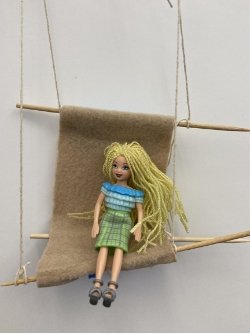
M O B I L I T Y S U P P O R T S Y S T E M
Em’s Chair: This mobile support system was co-designed during an accessibility class and involved Em, a client/participant living with multiple sclerosis. Em challenged our team of four to design something that could adapt to her ever-changing energy levels, that could be comfy, cozy – not cold and institutional – and that wasn’t overly complicated or super expensive.
ux principles
research
design
prototyping
usability testing
The daily hurdles?
How might we create a mobility support system that adapts to varying energy levels, is inviting to use, and encourages confidence?
Research goal: UNDERSTAND EM’S DAILY SITUATION
People with disabilities or handicaps live with an added layer of stress and mental intention that many of us don’t experience. In Em’s case, because of MS, she’s always considering her energy levels and strength; sometimes her body just won’t do what the brain wants it to do. While most of us enter our homes without much thought, she thinks about whether her body will propel her to the kitchen or bathroom before her legs give out. Often times, her body feels like jello or the legs do give out and she needs support along the way.*** This is Em’s normal.
Em plans to build an adaptable house prototype which she will be able to age in as her MS progresses. It’s not just ANY home, but one that will be modern and cozy and allow for experimentation and exploration by others. Who says a home has to have 4 corners, straight walls and a standard ceiling?
Design goal: FLEXIBLE
When I first heard Em talk about the adaptable house, I imagined George Jetson coming home from work, stepping onto a moving path with a chair popping up under him, his shoes slipping off, and carrying him away to his family. In theory, sort of. In reality, she wanted it to be inviting and welcoming and look like it could be for anyone but would also accommodate her disability. We landed on a soft, sling-like chair with pulley system mechanics and an existing motorized overhead gantry system to find the balance between mobility, flexibility, and simplicity.
Like the Jetsons?
More than a chair?
Em has been living with MS for the past 12 years and while she is doing okay with the aid of some wearable supports, MS brings on bouts of intense fatigue and sometimes a foggy brain that can knock her out of life for a few hours or days. She continues to swim daily and as a certified fitness trainer, she understands the importance of movement and exercise to lessen her aches and keep MS from overtaking her body.
Design goal: ENCOURAGE CONFIDENCE and PLAY
The pulley system helps Em ease into and out of the chair. It would be fully motorized to assist her on the days that she’s feeling tired and would be manual on the days that she wants to stretch, hang, and exercise her own strength. She could walk with it in front of her as support or simply sit and rest.
The gantry track system above would function like an automatic belay and be responsive to her movement much like the changing slack of ropes used during rock climbing.
Hygge what?
Hygge is a Danish term for a quality of coziness, comfort and contentment. Look it up on Pinterest and you’ll find settings of calm, comfy armchairs, a cableknit throw and breakfast tray with tea next to a fireplace. It makes you go “ahhh.” Em wanted “ahhhh.”
Design goal: MAY IT YUMMY
We researched the best of what institutional solutions had to offer in the way of safety and mobility and then re-thought the chair with a “hygge” sensibility to create a solution that is comfortable and inviting. We chose warm soft colors, added tassel details, a cushioned a headrest, and extra fluffy padding in the boho aesthetic that is Em’s style.

R E F L E C T I O N
We got as far as a scaled-down prototype demonstrating ideas around materials and general functionality. // We jerry-rigged a full-size, very rudimentary pulley system with broom handles, rope, clamps, and canvas from a camping chair (Prototype #4) to test our mechanical assumptions. It worked. // Truthfully, though, a sling chair is a bit too flimsy and awkward to get in and out of even with the pulley assistance. // More research and iterations are required to find the right balance between material choice, stability, comfort and style.
Below you will find the behind-the-scenes work of our idea.
Discovery + research
4
Days of diary study by Em
1
90-minute semi-structured interview with Em
2
90-minute co-design sessions with Em
+
Hours of research and reviews on technology, mobility systems, chairs and chair ergonomics, TRX equipment, bungee yoga fitness, trapeze gear, adaptive climbing gear, gantry systems, multiple sclerosis
We did alot of research about MS and support systems but Em provided the most insight. She's had MS for many years and has had time to think about what she wants.Prototypes
Prototype #1:
paper, string, skewer sticks
Prototype #2:
felt, string, chopsticks
Prototype #3:
felt, yarn, wooden dowels
Prototype #4: functional
broom handles, ropes and straps, clamps, canvas chair cover (human-sized)
Other ideas
Prototype #4 revealed that despite the pulley system, a hanging sling chair is still not easy to get out of and required alot of core strength.Ideas that looked hard and stiff were quickly dismissed. An overhead system intriqued Em. It invited stretching and support in a different way. Em liked the idea of how a bungee cord system and stretchy yoga fabric could inspire movement and playfulness.
F I N A L R E F L E C T I O N








